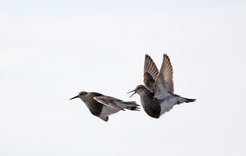Speed Dating: Promiscuous pectoral sandpipers sample breeding sites along thousands of kilometres
The shorebirds have a huge breeding range across the Arctic
After having journeyed half way across the globe to reach their breeding grounds in the Arctic, male pectoral sandpipers fly thousands of kilometres more through their breeding range. Bart Kempenaers and Mihai Valcu of the Max Planck Institute for Ornithology in Seewiesen discovered that these birds are always ready to move on and visit up to 24 potential breeding sites. Presumably they are searching for mating opportunities to increase their reproductive success.

The mating system of pectoral sandpipers (Calidris melanotos) is called male dominance polygyny. This means that males compete intensely for females, but leave them without any resources but sperm and without any investment in care for the offspring. Instead, males and females limit their interactions to short, not-so-romantic interludes. As shown in a former study led by Bart Kempenaers and including sleep researcher Niels Rattenborg from the Max Planck Institute for Ornithology in Seewiesen, competition among males is so high that males have to reduce their sleep and defend and court females virtually non-stop throughout the endless arctic summer days to successfully reproduce. In the end, only few of the competing males will be able to sire offspring under these conditions.
Highly elaborate courting rituals, exhausting fights with rivals, hardly any sleep and a male can consider himself lucky to gain a copulation. Do most of the males go through this ordeal for nothing? Behavioural ecologist Bart Kempenaers has studied pectoral sandpipers for more than 13 years. He saw males arriving on the study area in Barrow, Alaska, staying a few days, then leaving again. The data showed that how long males stayed in Barrow strongly depended on how many fertile females were present. Males that stayed longer also sired more offspring. But did that mean that the males who left earlier simply gave up? To find out where these males were going, Bart Kempenaers and Mihai Valcu, a researcher in his group, radio-tagged 120 males upon their arrival in Barrow.
Most of the study males remained in northern Alaska. Instead of comfortably settling to enjoy the short breeding season, most males were quick to embark on a new race against the clock. The majority showed nomadic behaviour with large-scale movements across the Arctic, visiting up to 24 potential breeding sites. “Some males even visited areas with suitable breeding habitat past the western and eastern extents of the known breeding range”, says Kempenaers. Traveling another 14000 kilometres after a trip of about the same length from the southern hemisphere is apparently no problem for this ~100 gram bird: “It seems that flying cannot be all that costly for those animals”, remarks Kempenaers.
After completing their long spring migration, pectoral sandpiper males cannot easily afford to waste breeding opportunities. Hence, if locally unsuccessful, males will try their luck elsewhere. And even if successful, traveling to additional breeding sites can add to a male’s breeding success. “The males move through the whole breeding range to increase their chances to reproduce several times during one breeding period”, speculates Valcu. These movements are expected to lead to a population with little genetic differentiation, and little opportunity for local adaptation that allows the evolution of subspecies.
SSp/HR












